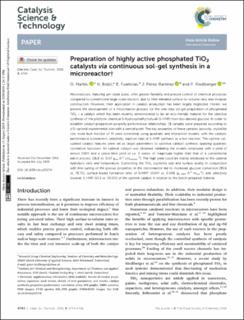Please use this identifier to cite or link to this item:
https://doi.org/10.21256/zhaw-18049Full metadata record
| DC Field | Value | Language |
|---|---|---|
| dc.contributor.author | Martin, Oliver | - |
| dc.contributor.author | Bolzli, Nicole | - |
| dc.contributor.author | Puértolas, Begoña | - |
| dc.contributor.author | Pérez-Ramírez, Javier | - |
| dc.contributor.author | Riedlberger, Peter | - |
| dc.date.accessioned | 2019-08-29T15:02:23Z | - |
| dc.date.available | 2019-08-29T15:02:23Z | - |
| dc.date.issued | 2019-08-13 | - |
| dc.identifier.issn | 2044-4753 | de_CH |
| dc.identifier.issn | 2044-4761 | de_CH |
| dc.identifier.uri | https://digitalcollection.zhaw.ch/handle/11475/18049 | - |
| dc.description.abstract | Microreactors, featuring μm-sized tubes, offer greater flexibility and precise control of chemical processes compared to conventional large-scale reactors, due to their elevated surface-to-volume ratio and modular construction. However, their application in catalyst production has been largely neglected. Herein, we present the development of a microreactor process for the one-step sol–gel preparation of phosphated TiO2 – a catalyst which has been recently demonstrated to be an eco-friendly material for the selective synthesis of the platform chemical 5-hydroxymethylfurfural (5-HMF) from bio-derived glucose. In order to establish catalyst preparation–property–performance relationships, 18 samples were prepared according to a D-optimal experimental plan with a central point. The key properties of these samples (porosity, crystallite size, mole bulk fraction of P) were correlated, using quadratic and interaction models, with the catalytic performance (conversion, selectivity, reaction rate) of 5-HMF synthesis as a test reaction. The optimal calculated catalyst features were set as target parameters to optimise catalyst synthesis applying quadratic correlation functions. An optimal catalyst was obtained, validating the models employed, with a yield of almost 100% and a space–time yield of ca. 3 orders of magnitude higher than that of a conventional batch process. The high yield could be mainly attributed to the optimal hydrolysis ratio and temperature. Controlling the TiO2 crystallite size and surface acidity in conjunction with fine-tuning of the porous properties in the microreactor led to increased glucose conversion, surface based formation rates of 5-HMF, and selectivity towards 5-HMF of the optimal catalyst in relation to the batch-prepared material. | de_CH |
| dc.language.iso | en | de_CH |
| dc.publisher | Royal Society of Chemistry | de_CH |
| dc.relation.ispartof | Catalysis Science & Technology | de_CH |
| dc.rights | http://creativecommons.org/licenses/by-nc/3.0/ | de_CH |
| dc.subject | Heterogeneous catalyst | de_CH |
| dc.subject | Microreaction technology | de_CH |
| dc.subject | Continuous manufacturing | de_CH |
| dc.subject | Process intensification | de_CH |
| dc.subject | Yield optimization | de_CH |
| dc.subject | Selective synthesis | de_CH |
| dc.subject.ddc | 540: Chemie | de_CH |
| dc.title | Preparation of highly active phosphated TiO2 catalysts via continuous sol–gel synthesis in a microreactor | de_CH |
| dc.type | Beitrag in wissenschaftlicher Zeitschrift | de_CH |
| dcterms.type | Text | de_CH |
| zhaw.departement | Life Sciences und Facility Management | de_CH |
| zhaw.organisationalunit | Institut für Chemie und Biotechnologie (ICBT) | de_CH |
| dc.identifier.doi | 10.1039/C8CY02574F | de_CH |
| dc.identifier.doi | 10.21256/zhaw-18049 | - |
| zhaw.funding.eu | No | de_CH |
| zhaw.issue | 17 | de_CH |
| zhaw.originated.zhaw | Yes | de_CH |
| zhaw.pages.end | 4758 | de_CH |
| zhaw.pages.start | 4744 | de_CH |
| zhaw.publication.status | publishedVersion | de_CH |
| zhaw.volume | 9 | de_CH |
| zhaw.publication.review | Peer review (Publikation) | de_CH |
| zhaw.webfeed | Chemieingenieurwesen | de_CH |
| zhaw.funding.zhaw | Kontinuierliche Mikroreaktoren für die Synthese von neuen heterogenen Katalysatoren und zur katalytischen Biomasseverwertung | de_CH |
| zhaw.author.additional | No | de_CH |
| Appears in collections: | Publikationen Life Sciences und Facility Management | |
Files in This Item:
| File | Description | Size | Format | |
|---|---|---|---|---|
| 2019_Martin_etal_Preparation-of-highly-active-phosphated-TiO2-catalysts_CatalysisScienceTechnology.pdf | 4.8 MB | Adobe PDF |  View/Open |
Show simple item record
Martin, O., Bolzli, N., Puértolas, B., Pérez-Ramírez, J., & Riedlberger, P. (2019). Preparation of highly active phosphated TiO2 catalysts via continuous sol–gel synthesis in a microreactor. Catalysis Science & Technology, 9(17), 4744–4758. https://doi.org/10.1039/C8CY02574F
Martin, O. et al. (2019) ‘Preparation of highly active phosphated TiO2 catalysts via continuous sol–gel synthesis in a microreactor’, Catalysis Science & Technology, 9(17), pp. 4744–4758. Available at: https://doi.org/10.1039/C8CY02574F.
O. Martin, N. Bolzli, B. Puértolas, J. Pérez-Ramírez, and P. Riedlberger, “Preparation of highly active phosphated TiO2 catalysts via continuous sol–gel synthesis in a microreactor,” Catalysis Science & Technology, vol. 9, no. 17, pp. 4744–4758, Aug. 2019, doi: 10.1039/C8CY02574F.
MARTIN, Oliver, Nicole BOLZLI, Begoña PUÉRTOLAS, Javier PÉREZ-RAMÍREZ und Peter RIEDLBERGER, 2019. Preparation of highly active phosphated TiO2 catalysts via continuous sol–gel synthesis in a microreactor. Catalysis Science & Technology. 13 August 2019. Bd. 9, Nr. 17, S. 4744–4758. DOI 10.1039/C8CY02574F
Martin, Oliver, Nicole Bolzli, Begoña Puértolas, Javier Pérez-Ramírez, and Peter Riedlberger. 2019. “Preparation of Highly Active Phosphated TiO2 Catalysts via Continuous Sol–Gel Synthesis in a Microreactor.” Catalysis Science & Technology 9 (17): 4744–58. https://doi.org/10.1039/C8CY02574F.
Martin, Oliver, et al. “Preparation of Highly Active Phosphated TiO2 Catalysts via Continuous Sol–Gel Synthesis in a Microreactor.” Catalysis Science & Technology, vol. 9, no. 17, Aug. 2019, pp. 4744–58, https://doi.org/10.1039/C8CY02574F.
Items in DSpace are protected by copyright, with all rights reserved, unless otherwise indicated.